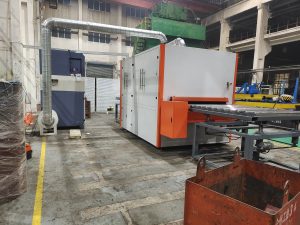In sheet metal fabrication, precision and quality are crucial. Laser cutting is one of the most popular methods for cutting sheet metal because of its speed, accuracy, and ability to handle intricate designs. However, laser cutting can leave behind burrs, sharp edges, and rough surfaces, impacting both the appearance and functionality of the part. This is where a deburring machine becomes essential.
Deburring involves removing unwanted imperfections, and ensuring the final product is smooth, safe, and ready for further processing or use. In this article, we’ll explore the reasons why choosing a deburring machine for laser-cut sheet metal parts is important and how it enhances efficiency, quality, and cost-effectiveness in your manufacturing process.

1. Enhanced Quality and Finish of Laser Cut Parts
Laser cutting provides high-precision parts, but it often results in burrs and rough edges due to the heat generated during the process. These imperfections can undermine the aesthetic and functionality of the part, making it look unfinished or affecting its fit during assembly.
Using a deburring machine removes these imperfections, resulting in a smooth, uniform finish. This improves the part’s appearance and ensures that it is easier to handle, fit, and assemble. Whether the part is undergoing further processes like welding, painting, or coating, deburring helps eliminate complications during those steps.
2. Increased Safety in Manufacturing
Burrs and sharp edges on laser-cut parts create safety risks for workers. These imperfections can lead to cuts, scratches, or more serious injuries, especially during manual handling. By using a deburring machine to remove these sharp edges, manufacturers create a safer work environment, reducing the likelihood of workplace injuries.
In industries where parts are frequently handled or assembled manually, deburring parts not only protects workers but also improves the ease of handling and reduces the risk of part damage.
3. Consistency and Precision in the Deburring Process
One key benefit of a precision deburring machine is its ability to perform the task consistently and accurately. Unlike manual deburring, which requires skill and time, deburring machines eliminate human error, ensuring every part meets the same high-quality standards. This is crucial in industries like aerospace, automotive, and electronics, where precision is essential.
Deburring machines automate the process, providing an efficient, consistent, and repeatable finish on each part, making them a vital tool for high-volume production.
4. Cost-effective and Time-Efficient Manufacturing
At first glance, the initial cost of a deburring machine might seem high, but the long-term benefits far outweigh the investment. Manual deburring methods can be slow and labor-intensive, especially when processing large quantities of parts. A deburring machine processes multiple parts at once, significantly reducing the time spent on this step.
Automating the deburring process increases throughput, reduces labor costs, and decreases downtime. This means manufacturers can produce more parts in less time, improving production efficiency and lowering overall lead times.
5. Versatility with Various Materials and Shapes
Deburring machines are highly adaptable and can handle a wide variety of materials and shapes. Laser cutting is used on materials like stainless steel, aluminum, and copper, each of which presents different challenges in deburring. A deburring machine is designed to accommodate these variations, ensuring effective processing for all types of materials.
Additionally, laser-cut parts often come in complex shapes, and deburring machines can be tailored to address these unique challenges, ensuring efficient deburring for parts of all sizes and geometries.
6. Minimized Risk of Part Damage
Laser-cut parts, especially delicate or thin materials, are prone to warping, bending, or cracking during manual deburring. Traditional methods, like abrasive grinding, can also damage the material.
Deburring machines are precise and gentle, applying just the right amount of force to remove burrs without causing damage. This is crucial for high-value parts where maintaining material integrity is essential. With a deburring machine, manufacturers can ensure parts remain intact and undamaged throughout the deburring process.
7. Environmental Benefits
Many deburring machines today are designed with environmental considerations in mind. Traditional manual deburring methods generate dust, debris, and waste, which can pose health and environmental risks. However, modern deburring machines often feature built-in dust extraction and filtration systems, reducing the environmental impact.
Investing in a deburring machine with an efficient dust collection system can minimize waste and protect workers’ health, ensuring a cleaner, safer, and more eco-friendly workplace.
8. Compliance with Industry Standards
In industries like automotive, aerospace, and medical manufacturing, parts must adhere to strict quality standards. Deburring machines help ensure parts meet these requirements by providing consistent, high-quality finishes that align with industry certifications such as ISO, ASTM, and more.
By using a deburring machine, manufacturers can maintain compliance with industry regulations, preventing costly rework, non-compliance issues, or product recalls.
The Importance of Investing in a Deburring Machine
Choosing a metal deburring machine for laser-cut sheet metal parts is a valuable investment with numerous benefits. From improving part quality and worker safety to increasing precision and efficiency, deburring machines offer a clear advantage over manual deburring methods.
By automating the deburring process, manufacturers can boost productivity, reduce costs, and improve the overall quality of their products. In industries where high-quality parts are essential, investing in a deburring machine helps ensure the success of your manufacturing operations, ultimately enhancing your competitive advantage.

